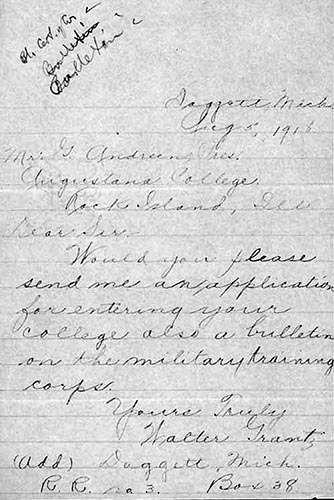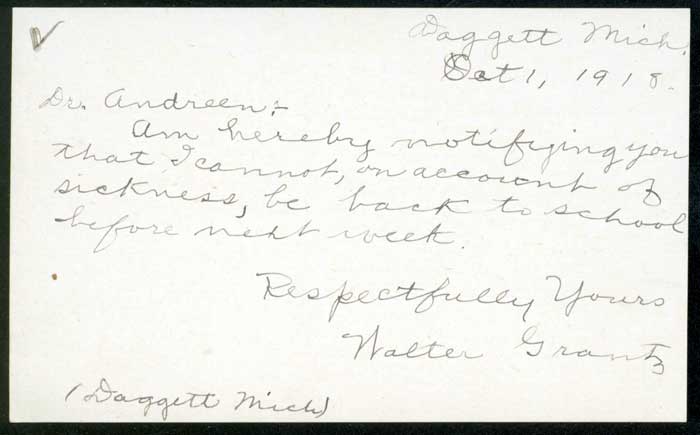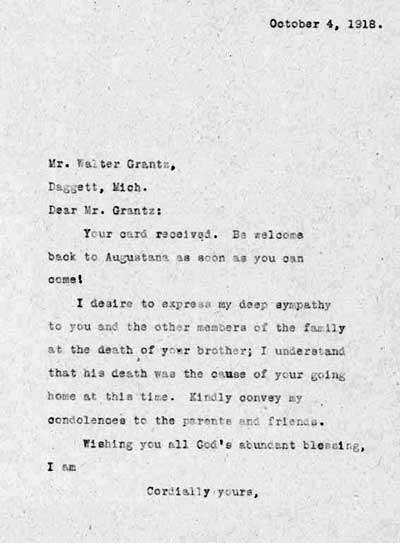1918 at Augustana: Soldiers and flu come and go

(This story was written in celebration of Augustana's sesquicentennial in 2010.)
When a young man named Walter Grantz sent his letter of inquiry to President Gustav Andreen in August of 1918, he was looking to attend Augustana that very same fall — registration took place Sept. 2 and 3 that year. Walter did enter Augustana as one of a record incoming 133 freshman students in the fall of 1918. Never before had the college enrolled so many students; the previous record had been set in the fall of 1913 with 75.
This spike in enrollment may have been caused by interest in the Students' Army Training Corps, which enrolled 140,000 men at 524 colleges across the country in the fall of 1918. Augustana's unit inducted 120 men when it was created in September 1918. The SATC prepared men for active duty (World War I was underway) and the government paid for room and board, tuition, and clothing for members of the SATC .
Four hundred and thirty four Augustana students and recent graduates served in the U.S. armed forces from 1917 to 1919, and an additional 19 served as chaplains and YMCA and Lutheran Brotherhood workers. Nine of these students and graduates lost their lives in service to their country.
Walter Grantz's college career was short-lived and his interest in military service unfulfilled when he died Oct. 7, 1918, the only Augustana student to die in the influenza pandemic of 1918. Walter sickened while home in Michigan for the funeral of his brother and died before returning to campus. Two siblings died shortly thereafter, leaving Walter's widowed father childless.
An estimated 50 million people — about 3% of the world's population at the time — died from the 1918 influenza and about 500 million worldwide were infected. This particular flu sickened young and otherwise healthy adults who often died within a few days.
October 1918 was the deadliest month in the United States. There were 195,000 flu-related deaths nationwide in that one month alone. The Rock Island County Health Department instituted a ban on public gatherings that closed schools, theaters, churches, and libraries in hopes of reducing the spread of the flu. Augustana was closed for four weeks due to this ban. By the end of October, one-fourth of the U.S. population had become ill.
An Oct. 10, 1918, letter from the Illinois Department of Public Health implored President Andreen in his role as a pastor to take precautions:
"Urge the members of your congregation to avoid the careless sneezer, spitter and cougher. Such persons are largely responsible for the present alarming spread of this disease...All rooms should be exceptionally well-ventilated and at the same time comfortably heated."
Such exhortations and the ban on public gatherings were not sufficient to shield Dr. Andrew Kempe, professor in the commercial department and treasurer of the college, who died Oct. 16, 1918. In a resolution from the general faculty, Kempe was referred to as a "beloved colleague" whose "genial, kindly, manly presence" would be missed. Professor Edward Fry Bartholomew noted in his Oct. 19 journal entry that Kempe's funeral was held outside, on the front steps of Denkmann Memorial Library, "on account of the Influenza Epidemic it was not allowed to hold services in any building."
Despite these deaths on campus, or perhaps because of the lingering threat of illness, the flu became a favorite topic for jokes and ditties in the Observer, including:
"We wonder if it is possible that the present epidemic of influenza, which is sweeping the country, is traceable to the recent drafts."
"I had a little bird/Its name was Enza/I opened the window/and in-flu-enza."
The Observer noted Dec. 1, 1918, that the "‘Spanish Influenza' has thus far knocked but lightly at our door," and, while true, this note was printed just a few days before Algert Anker, head of the violin department and third and final Augustana flu victim, died.
Despite a memorial to Professor Anker in the January Observer, the newspaper that month was upbeat and optimistic, with calls to "renew the old college spirit" and reschedule many of the social and musical events that had been suspended or postponed in the fall due to the war and the flu. The Students Army Training Corps had been disbanded in December (the war had ended in November) and while several veterans enrolled or returned to Augustana, very few of the SATC members continued at the college. Soldiers and the flu had both come and gone in the space of one semester.
— Jamie Nelson
Special Collections Librarian
The H1N1 virus was in the news as the special collections librarians were planning articles for this 150th website. In the fall of 2009 campuses around the country were isolating sick students, canceling classes and wondering how to plan for and react to a possible pandemic. I thought that researching how Augustana had weathered the 1918 pandemic might be an interesting comparison but found relatively little contemporary information about the 1918 flu. I expected to find that several students had died from the flu, but instead there was a very rich story about the one student, Walter Grantz, a farm kid from Michigan, who left a paper trail in the presidential papers held in the archives.



